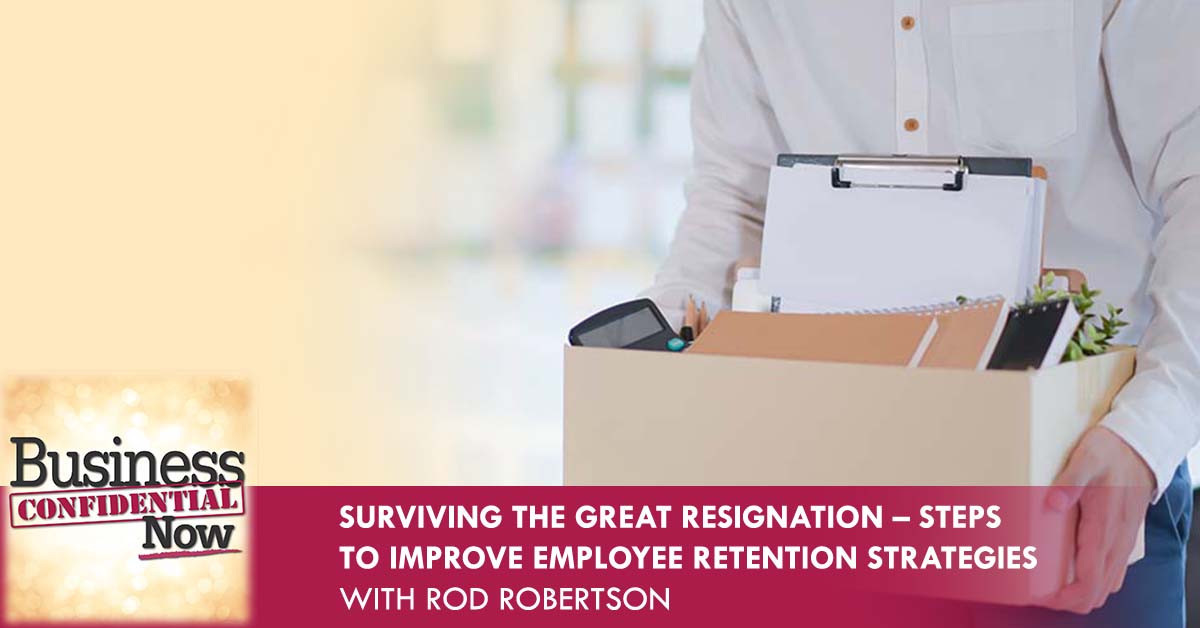
Photo Credit: © iStock | 12875116
Improving employee retention strategies in the wake of The Great Resignation is a high priority on many management lists. Hear Rod Robertson discusses the top things that small and mid-sized businesses should focus on to improve their employee retention strategies and avoid turn over. Best of all, Rod shares how those same factors empowered employees to make process improvements that drive business scalability and continuity.
What You’ll Discover About How To Improve Employee Retention Strategies
- The pivotal role profit sharing can play to improve employee retention.
- How relocation packages and flexible hours can improve employee retention strategies
- Why taking steps to improve employee retention strategies pays dividends down the road when selling your business
- And MUCH more
Guest Bio
 Rod Robertson is an international entrepreneur and co-author, with Stuart Robles, of The New World Of Entrepreneurship: Insiders’ Guide To Buying And Selling Your Own Business In The Digital Age. Robertson is the owner of Briggs Capital, a boutique international investment bank. He has conducted business in over 15 countries while focusing on developing small-to-medium-sized businesses and taking them to market worldwide. Robertson’s 20-plus-year career in transaction experience and entrepreneurship includes guest lecturing around the globe at institutions such as Harvard Business School and other top-flight MBA schools as well as business forums and news outlets worldwide. He sits on numerous boards, guiding firms to streamline operations and make businesses more profitable before selling.
Rod Robertson is an international entrepreneur and co-author, with Stuart Robles, of The New World Of Entrepreneurship: Insiders’ Guide To Buying And Selling Your Own Business In The Digital Age. Robertson is the owner of Briggs Capital, a boutique international investment bank. He has conducted business in over 15 countries while focusing on developing small-to-medium-sized businesses and taking them to market worldwide. Robertson’s 20-plus-year career in transaction experience and entrepreneurship includes guest lecturing around the globe at institutions such as Harvard Business School and other top-flight MBA schools as well as business forums and news outlets worldwide. He sits on numerous boards, guiding firms to streamline operations and make businesses more profitable before selling.
—
Surviving The Great Resignation – Steps To Improve Employee Retention Strategies With Rod Robertson
Looking to improve employee retention strategies in your business? Tired of spending time interviewing candidates only to hire them and then watch them walk out the door a short time later? You’ve come to the right place. Our guest is going to give you the latest thinking about reducing unwanted turnover in your workforce and why it matters. Stay tuned.
—
I’ve got a terrific guest for you in this episode. It’s Rod Robertson. He is a managing partner of Briggs Capital, a boutique international investment bank. He’s an international entrepreneur who’s conducted business in over fifteen countries while focusing on developing small to mid-size businesses and taking them to market worldwide. Rod’s also the co-author of the book, The New World of Entrepreneurship, and I’m excited to have him here. Welcome to the show, Rod.
What a pleasure.
The pleasure is all mine, Rod. Employee retention strategies have arguably never been more important than now. For businesses that are looking to improve their employment retention strategies, what, in your experience, are the top things they should focus on, especially for the small and mid-sized businesses that don’t have the resources a large cap company has?
Sixty-five percent of us are employed by small to medium size businesses that are under 100 employees. We all hear about the Amazons, FANGs and all the big companies, but the basis of the Foundation of America business has been for entrepreneurial and privately owned businesses. It’s a human-to-human game instead of these organizations where people are getting canned from some guy on the phone with 200 people getting wiped out in a day. Everything we do is so personal and small businesses to medium size businesses. It’s more important now than ever to retain your key employees and to treat them correctly in these changing and evolving times that have started with the pandemic.
It's more important now more than ever to retain your key employees and to treat them correctly with the changing and evolving times that started with the pandemic. Share on XWhat are the top things? They think they are doing the right things. They think they are being good asset stewards as far as their labor force and their employees go. A lot of them probably think, “This is like my family,” even though they’re not a blood relative. What should they be doing now to make sure, especially with the younger cohort that seems to want to change jobs every 18 to 36 months?
I think the younger cohort has to be patient and educate the older generation ahead of them, who are oftentimes dealing with archaic business management styles that they learned in the day of my way or the highway. Everyone’s taken the highway now, so it’s very difficult to impose your standards and your will on people like it was in the old days. What do I mean by the old days? Before the pandemic. The pandemic has let the boogeyman loose for some owners. It’s also a blessing for the owners and management that are in the groove. If they structure their company right and their incentives and what they can do for employees, they’re going to be able to get the best and the brightest from the people that aren’t catering to their employees the way they should.
Let’s talk about some of those incentive strategies, Rod, because when it comes to employee retention strategies, the smaller and mid-size companies don’t have that deep a pocket. What makes sense for them?
It’s giving up a piece of the pie. I’m always shocked. I’ve led 100 mergers and acquisition deals in the last few years at our firm. We’ve done a growth strategy. We’ve done so many different things, but there’s a common theme. The ownership, for some reason, is so stingy about sharing some of the profits. If you’re going to keep 10 or 15 great employees and you’re going to attract another 10 or 15 employees, they’re going to boost your revenues by 10%, 20%, 30%, 50% instead of you struggling along, the way, it is one brick at a time.
Why wouldn’t you sit there and cut these people in for 10% to 15% of the upside? They’ll have to stay. They’re going to have to earn into it, but let them take pride in the organization so that the owner can maybe take the pedal off the metal a little bit and sit back and relax. There are many different ways to approach how you can get these people to share it. If you or the company’s adverse to cutting key employees technically in the share program, there are 3 or 4 other different ways to go about it.
When you go in about it, it can be done in a fashion, but if the people don’t stick, it’s not like you’re going to give them a stock certificate and they’re going to take off. They have to earn into it anywhere from 2 to 4 or 5 years. Five years is a long time now. It’s like infinity in the way things are accelerating. You can set up profit sharing. This is nothing new that we’re talking about, but it means something now. How do you do it?
You grade out your employees. If it’s a smaller business, you can feel them out individually, so you don’t have to rank them and chart them. Nobody has to know what you’re given each one of them, but those people when, if they’re sitting there for 2 years into a 4-year situation, vesting period with you, they’re not going to leave and that last year or year and a half. That could mean heightened valuations of your company. It could mean all sorts of things to keep your employees.
One thing that we’re hearing a lot about is boomerang employees. Before the pandemic, the owners had everyone under their thumb. Now, the thumb is gone. People are coming and going like crazy. Companies and owners were slow to react and they would sit there and say, “The hell with him or her. I’m going to hire somebody else to do it.
Those days are over. We all know that. The marketplace is radically altered to the point where the employees are leaving for supposedly greener pastures. What have you done? The managers and owners have made a mistake and they’re bringing in green people that have to train all over. Somebody they don’t know, maybe somebody they met on Zoom and they have no personal rapport with.
These boomerang employees, when you swallow your pride a little bit and you go out there and you go back to them and say, “We miss you. We need you back. We want you back and I’m going to put my money where our mouth is. I want you to be part of the profit-sharing and ownership of the company. Studies are showing that 20% or 30% of the people are jumping to come back and you don’t have to train them. They’re ready to go. Perhaps they weren’t having such a great experience in the new world. They come back re-energized and it’s a whole new ball ballgame.
That makes a lot of sense, and I can see where there are a lot of appeals and how it could be successful. With those Boomerang employees, when it comes to employee retention strategies, let’s not forget that those employees left for a reason. They’re going to come back and a bunch of carrots is being dangled in front of them to incentivize them but does that change the reason they left? I’ve seen studies that say people don’t leave because of the money. They leave because of the leadership.
Yes, but maybe it’s because I’m a bit of a merch and have always been around the money and always doing something quantitative. It is about the money in the end if people are leaving. I think it’s 50/50. There’s this whole new school of thought, which I think is great. People now, if you’re trying to draw somebody to where you’re working and if you’re working is not exactly downtown or in the best area or suburb, people are giving people first and security deposits on an apartment.
People are helping people with closing costs on their homes to tie them into the game and get them to relocate close to the office so that they can jump. They’re a little bit tethered. Using this real estate angle has worked out very well for some people. People have subsidized people’s rent. The rents have gone through the roof, let alone the interest rates. People are going to listen to it if part of the package is, “For the first year, we’re going to subsidize it and at the same time, you’re going to do some profit sharing with us.
You’re getting your salary and you’re doing it right. Again, all this is an extra 20% layered on for owners and managers to have to absorb, but it’s better to hold the fort down than to, uh, to take three steps back because who wants to go building the business again, a brick at a time if someone’s knocked your wall down.

Employee Retention: It’s better to hold the fort down than to take three steps back. Who would want to go build the business again a brick at a time if someone’s knocked your wall down?
That’s a good way to look at it and I think being able for especially smaller business owners and founders who have built something from scratch. For them, this is their baby and it’s hard to let go. Helping them with that mindset to look how much more you can accomplish if you let other people truly help them and let them share in some of this success that it’s not necessarily giving up all control, which is probably a big, big fear.
Building the business a brick at a time is so painful, but that’s the way it was done in the last 30 to 40 years in the majority of American businesses. That day is now with the scalability and the internet and the way people can sell “Get new customers.” Scaling is so rapid and that’s why owners have been very happy to have or were growing at are steady 10% a year for 10 years. That is good, especially when the ups and downs of the economy are moving about and inflation and other bugaboos are out there.
Sitting there and sitting back and going, “Why don’t I bring on three strong people and time to the mass with me and maybe I can relax a little bit? These people are probably younger so you can go ahead and do it. For the young people who are unfettered with this archaic thinking, they can jump deep into this game, play Mr. and Mrs. Flexibility, and just get it going right out of the shoot and let these people help build your business into a rocket ship.
With your unique cap bird seat in capital markets and mergers and acquisitions and helping, companies take to the next level and so forth when it comes to deal-making, tell me about the role employee retention strategies play in the valuation process.
I say there are 80 employees and 8 are senior managers. The buyers are going to go, “The seller made sailed off into the sunset, but at the very least, they’re taking the pedal off the metal. And so they are going to sit there and start coasting a little bit. They can’t help themselves. They’re going to be getting 7 or 8-figure money. Everyone’s going to slow down a little bit. Who’s behind that person? We’re working on 4 or 5 sales right now where the people want to jettison, enjoy life and who are they bringing up underneath them?
People are leaving millions of dollars on the table by not grooming the next level of management. Even if you’re 40 years old and everyone with you is 30 or you got to find those people in their late 20s or early 30s who have that 10-year gap that energy vacuum ahead them of a decade that they can push it forward. The buyers are so smart these days and we always hear about bad buys.
You are leaving millions of dollars on the table by not grooming the next level of management. Share on XI’m telling you, most of these buyers, I’ve been doing it a long time and they’re not friends of mine. At Briggs, we get five inquiries a day from people with over 200 million looking to buy a small and medium-sized business because the stock market’s very shaky. No matter what year or what time it is, up or down, inflation, deflation, elections, whatever it’s going to be, there’s so much money that’s better suited to be in small to medium-sized businesses. These people are only going to invest in a company that if management is maturing, there’s going be a next-generation growing underneath it.
How do they evaluate that leadership besides age?
The people always say, “How old are they or how long have they been here? How long is their employment contract?” I’d say 30% to 40% of our transactions, on 100% of the transaction, people will sit down and say, “I have to talk to you and the five managers before we close the deal.” Out of that, I’d say 30% to 40% of the buyers sit there and say, “I want these people signed up,” and we want to define their role.
A lot of times, they’re going to elbow the seller from the track, which can be good or bad because it’s opening up a Pandora’s Box. You should have the lid on these people as a seller and all of a sudden, the new owner is saying, “I like what Bob’s doing over here and I think you’re going to have to integrate it into your thought pattern.”
You’ve been holding Bob off for twenty years on his thought, but now, he’s smirking because there are younger and brighter people who are stroking a check for millions by telling him, “Bob, this is the way to go.” You got to be prepared for a change of your own and if you’re Bob sitting in the wings, get ready because your time is coming. Every company now is for sale, even if it’s not. If you look at Elon Musk, he’s out there monkeying around with Twitter and all these different things. Everybody’s for sale even if they’re not. It’s the American way.

Employee Retention: Everybody is for sale even if they’re not, it’s just the American way. Be prepared to sell, because if you’re not, you can leave millions and millions of dollars of equity on the table that are not related to your cash flow.
If everything’s for sale, why don’t you be prepared for sale? Because if you’re not, you can leave millions and millions of dollars of equity on the table that are not related to your cashflow. If your cashflow, your bottom line is $3 million and someone’s going to pay you a multiple of five on the bottom for $15 million, what they’re going to say if you’re not prepared for the deals, “I’ll give you $10 million in cash upfront and your company should be worth $15 million, but you have to do this, this and this over the next few years and we’ll give you that extra $5 million.
Now, off into the sunset. Sure, you’re getting your first whack of cash, but then you’re going to have to push hard to stay in the game for that extra three years. For a lot of people, it’s awesome because most entrepreneurs lead their life in their business and they don’t have a lot of hobbies. Their works are hobbies, so they can carry on with this and they do, but it may not be for everybody.
That’s true and sometimes, it’s the health issues that cause them to reconsider and then there’s not a lot of runways left. What do you think is holding entrepreneurs back, the ones that are not as open-minded as you’d like them to be, the ones that hold on to too long that keep Bob in his place and that type of thing? What do you think their biggest fear is?
Their biggest fear is they don’t know that outside of their world, they’re great at what they’re doing. Most business owners have 70% of their wealth inside of their business, locked inside and it’s not an easy thing to get it out. Everything’s changing with the employees. I finished a European tour where I visited seven countries and met with different economic groups trying to get a grip on what they were doing. The thought pattern, people have no idea that the average full-time American works 34.9 hours.
The French, the Germans and the Italians are averaging 26 to 29 hours. They’re all working a little bit less these days and people are demanding more flex time. Over in Europe, they’re looking hard at the four-day workweek. If ownership here in the States, if the people are sitting there and you got people working for 40 hours. If you did four 10 hours and you gave them a three-day weekend, instead of hammering it out, they don’t have to drive as much and all of a sudden, they can be with their kids.
They can make take trips. They can do it. You can get the same productivity out of people on a four-day workweek. It’s going to be coming a lot to the States now only because the log jam was broken up with the pandemic and everyone working from home. Given it or not, they’re taking that extra day and half of it is set up for leisure. We all hear about people working at home and they’re always connected. That may be true, but I would say over 50% of the people are enjoying themselves with a little more walks, a little yoga and playing with the kids and the pets. It’s a different game out there, but a great way for people to get one up on the competition, get the boomerang, and draw new employees is to consider going to a 40-hour week.
What would you say the most important thing is that you want small business owners, entrepreneurs, and mid-sized companies to know about employee retention strategies?
One of my big ones is maybe it’s because I owned the pet food company when I was an owner but look at the pets that people want to bring to work. Have a great pet program, along with the housing. There are 4 or 5 different buckets to profit sharing. If you give somebody five unrelated buckets to look at, someone’s going to want that. Who knows what the gal with 2 or 3 cats that wants to bring her cats to work or the people who have dogs and you’re sending dog sitters out for them or dog walkers.
It’s showing that you’re a human being as a boss and mixing it up with the ability to make money, I think, is a real winning strategy for managers and owners. Right now and for the foreseeable future, the unemployment rate’s not going to go really high, so there’s going to be competition and they may swing from the unemployment from 3 to 6 or wherever it’s going to be, but the great employees are always working. You’re not going to find a great employee who’s slinging his resume over the internet to you with a bundle of twenty others.
Just by showing that you're a human being as a boss and mixing it up with the ability to make money is a real winning strategy for managers and owners. Share on XYou’ve co-written a book, The New World of Entrepreneurship. Is there more to the new world of entrepreneurship besides great employee retention strategies that people need to be aware of?
In the world of entrepreneurship, it’s so much easier now to become an entrepreneur. All the money that’s out of the stock market, where is it? There are billions of dollars and thousands of organizations that are sitting out there waiting to invest in entrepreneurs, be they 30, 50 or even 60, with the people with the knowledge. Everyone has an angle on something that they did and the true business warriors have something that other people want, so they should pay for it. There’s never been and there haven’t been more businesses started in the last eighteen months than prior. People are having it and this work at home has shown people that they can be independent and they can accomplish everything.
I remember I’d be at work at 8:00 after an hour of a frenzy getting there. I’d get there at 8:02 and my boss would look at his watch and say, “Is somebody sick at home?” This was the nonsense that I had to deal with. Maybe it’s not as draconian for other people, but those days are gone and it’s awesome. There’s never been a time to be a better time to be a key employee. If you’re an employee, you are doing the boss and the owner of favor if you make and come forth with some ideas that will make you a happier and more productive employee.
If you have to leave for kid pick, if you want to go to your kid’s sports or whatever it is, you don’t want to be sitting there brewing and you should be able to go into the ownership of the manager and say, “I’ll be a better and more productive employee if you can work with me on my schedule and my schedule will not allow me to work on Fridays. I’m willing to do some spot work over the weekends. Monday to Thursday, I’m good to go. I’ll be your top worker, but let’s talk about a four-day workweek for me.”
If it doesn’t fit after a while, my family comes first. The key employees, the employees who are jump, jump, jump, it’s a different program for them because people can see that they’ve jumped, so what’s going to stop them now? Maybe stopping them is having a good program, but there’s not as much trust there. If you’re good at working with the founders, managers and owners, then sit down and come up with a really nice strategy that you think would benefit the company and you. Submit it.

Employee Retention: Sit down and come up with a good strategy that would benefit you and the company and submit it. keep it between you and the ownership and just go and talk to them. You’ll be very surprised that they’ll respect you for coming in.
Don’t go broadcasting it to your coworkers or asking them for feedback because the owners don’t want almost a quick storm of people approaching them with the same ideas. Keep it between you and the ownership and go and talk to them. You’ll be very, very surprised that they’ll respect you for coming in. What are they going to do? They’re going to say no. If they say no, you go back to work and you’re a little silent. They’re going to sit there at night and think, “I have to keep her. She’s awesome and I want her to stay.” For 20%, 30%, or 40% chance, they’ll come back and say, “I reflected upon what you said. Let’s take the first step together on this.”
That’s also great advice right there, Rod, for the owners who get approached. Maybe their initial reaction would be, “No way, I can’t do this,” but maybe the better choice is to say, “Let me think about it and get back to you,” because then they’ll have time to reflect. They might be able to cobble something together that makes everybody happy.
If you know someone who’d like to improve their employee retention strategies, please tell them about this episode, share the link and leave a positive review so others can find it too. You can do that on your podcast app or over at LoveThePodcast.com/businessconfidential. Thanks so much for tuning in. Have a great day and an even better tomorrow.
Related Resources
- https://TNWOE.com/
- https://www.LinkedIn.com/in/roderickrobertson/
- LoveThePodcast.com/businessconfidential
- Briggs Capital
- If you liked this interview you might also like these Human Resources episodes
Join, Rate and Review:
Rating and reviewing the show helps us grow our audience and allows us to bring you more of the rich information you need to succeed from our high powered guests. Leave a review at Lovethepodcast.com/BusinessConfidential
Joining the Business Confidential Now family is easy and lets you have instant access to the latest tactics, strategies and tips to make your business more successful.
Follow on your favorite podcast app here as well as on Twitter, Facebook, YouTube, and LinkedIn.
Download ♥ Follow ♥ Listen ♥ Learn ♥ Share ♥ Review ♥ Comment ♥ Enjoy
Ask Questions or Recommend a Topic/ Guest:
- Use our convenient Get in Touch form
- OR e-mail feedback(at)BusinessConfidentialRadio.com
Disclosure:
This post may contain links to products to products on Amazon.com with which I have an affiliate relationship. I may receive commissions or bonuses from your actions on such links, AT NO ADDITIONAL COST TO YOU.
